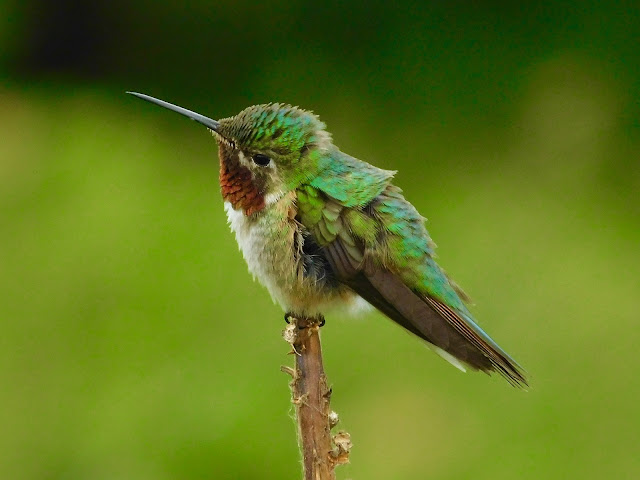Broad-tailed Hummingbird - An Energetic Visitor
 |
| Broad-tailed Hummingbird |
Rocky Mountain summers are distinguished by warmer temps, colorful wildflowers and the metallic trill of thin air whistling through the wings of tiny migrants. Zooming through our high meadows, the broad-tailed hummingbird is an energetic visitor.
Bursting onto the scene around May, they arrive from their sun-drenched homeland situated south of the border. These hearty birds have developed a unique characteristic that allows them to survive the harsh conditions present at such a high altitude.
Broad-tailed hummingbirds save enough energy to survive the bitterly cold nights by lowering their internal thermostat, becoming hypothermic. This reduced physiological state is an evolutionary adaptation that is referred to as torpor.
Torpor is a type of deep sleep where a bird's heart rate drops, breathing slows and its metabolic rate lowers by as much as 95%. By doing so, a torpid hummingbird can save up to 60% of its available energy as opposed to when it's awake.
Their diminutive nature is complimented by an elegant palette of iridescent colors that sparkle in bright sunlight. Adult males are described by a dazzling ruby-red throat, green crown and back and white underparts with green flanks.
The females are single parents burdened with the domestic tasks of nest building, incubating the eggs and feeding the brood. The promiscuous males flit about on a quest for the foothill's sweetest nectar while defending their territory with considerable zeal.
These little dynamos perform an impressive array of arial maneuvers when hunting for spiders, small insects and sugar water feeders. Propelled by powerful muscles and a limber shoulder joint, they can flap their wings at an astonishing 50 beats per minute.
By late August these forest jewels begin making their way back to the Mexican highlands where they will spend the winter. Their sudden disappearance is a sure sign of changing seasons and the start of a new school year.
 |
| An energetic visitor |
 |
| Bursting onto the scene |
 |
| Hearty birds |
 |
| A diminutive nature |
 |
| Colors that sparkle |
 |
| A little dynamo |
 |
| A forest jewel |



No doubt hummingbirds are the most energetic birds. they keep on migrating to different places with the changes in seasons. I think the thing which attracts the most to flying hummingbirds is the neat and clean feeder with full of food.
ReplyDelete